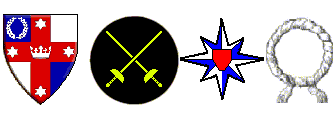By Aylwin Greymane
Originally published in Punta Dritta July AS XXXVIII (2003)
The biggest single problem we have faced to date in Innilgard has been a supply of gorgets. The major part of the problem has been getting access to anyone with a supply of suitable metal and tools to then work it with, who is in commuting distance for those who are short on transport.
Having had a quarter hide sitting in my shed for the last 4 or 5 years, I finally decided to put aside a day to try making a gorget from leather and testing it out. The leather was bark tanned and it was the minimum 4mm thickness required by the Lochac Rapier rules, but it was flexible leather, unlike the preferred ‘masonite’ leather, so I was a bit dubious about it.
The strips for the front and back of the neck were cut 8cm deep and roughly 17cm long to fit round my neck comfortably. Aviator-style tinsnips ($10 or less from your local hardware store) cut the leather very easily, as did dressmakers scissors. The two pieces were attached to each other with a soft but thick leather hinge and split rivets, two per side, on one side, and a strap and buckle the other.
I then taped blue closed cell foam on both bits, strapped it on and experimented by getting poked gently with a fibreglass blade and then steel schlager and hanwei blades. The leather deformed quite a bit for all of the blades, even with being strapped on quite firmly and the hits by necessity being fairly soft. As it was, I certainly wasn\’t going to wear it into combat.
A bit more searching in the shed unearthed some galvanised iron, about 20 gauge since it was fractionally under a millimetre thick. It was a flat piece but the usual rippled stuff beaten flat with a hammer would also suffice. Possibly even better since galv will take a small amount of gentle work hardening. I cut two segments about a centimetre and a half less deep and about two centimetres less wide than the leather, again with the aviator snips which made easy work of the iron. These were then curved over a handy tree branch with bare hands, secured to that shape with a few hammer taps, then riveted to the gorget with split rivets, two per side. The closed cell foam was then glued on.
There was an immediately noticeable difference to the gorget\’s stiffness. If I bent it by hand unfastened, it would still deform but I now needed a lot more pressure from both hands to make it deform. I then strapped it on and had the poke test re-performed. It turned out the iron made all the difference when the gorget was strapped in place. I took a number of throat shots, including a few that would have had me screaming at the culprit in a combat situation, and came out very satisfied.
From observation, when strapped on the gorget does deform very slightly under a direct hard thrust from a steel blade but then springs back into the curve again. The combination of leather, iron and foam means the force of any throat hit gets spread across the neck instead of concentrated in one spot. As the wearer, I felt no discomfort from the shots and never felt I was in any danger of getting hurt.
I then put the necessary extra segments on to cover the throat hollow and the cervical vertebrae so that it was fully legal, dyed it blue for looks, and spent an hour or two fencing against my normal partner. He managed a shot or two into the gorget and it was no more noticeable than if I had been wearing my normal steel gorget.
End result was a usable and legal gorget that took me a couple of hours to make, could be created out of easily obtainable, cheap materials and could be made with the normal tools found around a home, without any need for the use of metalworking tools.
One caveat though; I wouldn’t ever wear it in heavy combat. While very adequate in spreading the force of a direct thrust from a rapier, I think a crushing blow from an SCA sword or mace across the throat while wearing this style of gorget would cause massive deformation of the metal just from the power of the impact, and create subsequent possibly serious problems.
If anyone has any questions or comments, I can be contacted via my contacts page.
In service
Don Aylwin Greymane – Provost of the Royal Guild of Defence
